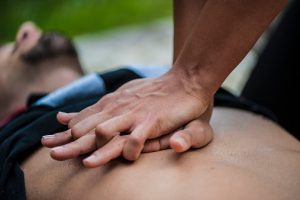
Although both events affect the heart, they are quite different. So, let us help you have a better understanding of these cardiovascular events by revealing the differences between a heart attack and cardiac arrest.
Heart Attack versus Cardiac Arrest
A heart attack occurs when a part of the heart becomes damaged because of inadequate blood flow. This commonly occurs due to a blockage in the specified area of the heart. Common causes of blockages result from cholesterol and plaque build-up in the arteries.
Cardiac arrest, on the other hand, refers to the electrical aspect of the heart. When there is an electrical malfunction of the heart, it is known as cardiac arrest. In cardiac arrest, the heart may be beating irregularly, erratically, or not at all. In this case, oxygenated blood can’t get to the other vital areas of the body, which can cause a person to pass out almost instantly.
Although a heart attack can lead to cardiac arrest, the majority do not.
Damage caused by heart attacks and cardiac arrest is possible but can vary. To determine the extent of the damage, an echocardiogram is used — an ultrasound for the heart. The severity of the heart attack will determine how much lasting damage there is.
In either case, it’s incredibly important to call emergency personnel immediately if you suspect someone is having a heart attack or going into cardiac arrest. The more time that passes without proper treatment, the worse the outcome can be.
Differences in Symptoms of Heart Attack and Cardiac Arrest
Common heart attack symptoms include uncomfortable pressure or tightening of the chest; pain or uncomfortableness of the arm, back, or jaw; shortness of breath; sudden nausea or vomiting; lightheadedness or dizziness; and unusual fatigue.
If you experience frequent episodes of chest pain and discomfort; irregular heartbeat; heart palpitations; unexplained changes in breathing including shortness of breath, fainting, or near fainting; or dizziness and lightheadedness. then you need to see a doctor right away.
When the heart stops. you only have a short amount of time to get emergency help before the lack of oxygenated blood to the brain can lead to lasting problems. The longer you wait for help, the higher the risk of permanent damage or even death.
What Are the Differences in Treatment Methods of Heart Attack and Cardiac Arrest?
If a person appears to be unconscious, you should begin CPR for one minute and then call 911. If you are trying to rescue a child, perform CPR for two minutes, then call for emergency help. When an AED is available, it is best to administer one shock, then start CPR.
It is advisable to start chest compressions by putting the heel of one hand in the center of the victim’s chest and cover the first hand with the other hand. Use upper body weight to push down on the person’s chest at about 100 compressions per minute. You can continue chest compressions until emergency help has arrived if you are not trained in CPR.
Those who are trained can gently tilt the head back and lift the chin to open up the airway after about 30 compressions. If the person isn’t breathing, give them two breaths. Pinch the nostrils shut and give a one-second breath. If the chest does not rise, give the second breath.
When it comes to defibrillation, the machines are programmed to recognize ventricular fibrillation and shock only when it’s appropriate. Portable defibrillators can be found in a number of public places today.
Once a patient of sudden cardiac arrest arrives in the emergency room, medical staff works hard to stabilize the condition. This includes administering medications. An implantable cardioverter-defibrillator may be recommended once a person has been stabilized. It is inserted near the left collar bone with one or more electrode-tipped wires running through veins and into the heart. It can send out low or high energy shocks when necessary.
Medicinal heart attack treatments include:
- Painkillers
- Aspirin (taken as soon as symptoms commence)
- Blood-thinning medications
- Antiplatelet agents
- Thrombolytics
- Nitroglycerin
- ACE inhibitors
- Beta-blockers
Your doctors will most likely commence treatment with medications and only resort to surgery if those don’t produce the desired effect.
Surgery for a heart attack could involve a coronary angioplasty to open up any blocked arteries, which may reduce the risk of serious arrhythmia. Coronary bypass surgery, which involves sewing veins or arteries in place in an area beyond a blocked or narrow artery, is an option. Radiofrequency catheter ablation, a procedure that focuses on blocking a single abnormal electrical pathway, is also a possibility. In some situations, such as a deformity or diseased heart muscle, corrective heart surgery is required.
Fortunately, there are a lot of preventative measures you can incorporate into your everyday lifestyle to prevent yourself from suffering a heart attack or sudden cardiac arrest. The first step is eating healthy and wholesome foods, exercising on a regular basis, quitting smoking, and reducing your alcohol intake as much as possible. If you’re concerned about your heart health, talk to your doctor about coming up with a personalized health care plan to get you on the right track.
Also read: